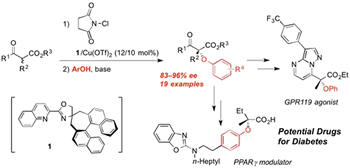
ここからコンテンツです。

New synthetic route to potential medicines for type 2 diabetes
Highly enantioselective synthesis of tertiary alkyl aryl ethers By Kazutaka Shibatomi
Kazutaka Shibatomi and his colleagues have found that the SN2 reaction of α-chloro-β-keto esters with phenols proceeded smoothly despite the fact that the reaction occurred at a tertiary carbon. This method allows the highly enantioselective synthesis of α-aryloxy-β-keto esters for the first time. The resulting compounds can be converted into some biologically active compounds, such as a GPR119 agonist, for the potential treatment of type 2 diabetes.
Aryl alkyl ethers are important structural motifs found in many biologically active compounds. Therefore, stereoselective etherification is a highly important synthetic operation in the preparation of drug candidates. However, very few enantioselective methods have been described for the synthesis of chiral tertiary aryl ethers.

Kazutaka Shibatomi and his colleagues have found that the SN2 reaction of α-chloro-β-keto esters with phenols proceeded smoothly despite the fact that the reaction occurred at a tertiary carbon [1]. They previously reported the highly enantioselective chlorination of β-keto esters with a chiral Lewis acid catalyst [2]. Thus, in the two investigations, they have successfully demonstrated the enantioselective phenoxylation of β-keto esters. This novel method allows the synthesis of α-aryloxy-β-keto esters with high enantioselectivity.
"Etherification by the SN2 reaction is an older synthetic method called Williamson ether synthesis, but very few researchers have succeeded in conducting this reaction with tertiary halides," said Associate Professor Kazutaka Shibatomi. "This is the first example of the enantioselective synthesis of α-aryloxy-β-keto esters, which would be useful synthetic intermediates for new drug candidates."
Using this method, the researchers demonstrated the synthesis of some biologically active compounds, such as a GPR119 agonist and a PPARγ modulator, for the potential treatment of type 2 diabetes. The researchers expect that the present method will also be helpful in preparing other types of synthetic drugs.
References
Kazutaka Shibatomi, Manato Kotozaki, Nozomi Sasaki, Ikuhide Fujisawa, and Seiji Iwasa (2015). Williamson ether synthesis with phenols at a tertiary stereogenic carbon: formal enantioselective phenoxylation of β-keto esters, Chemistry - A European Journal, 21(40), 14095-14098, 10.1002/chem.201502042
Kazutaka Shibatomi, Yoshinori Soga, Akira Narayama, Ikuhide Fujisawa, and Seiji Iwasa (2012). Highly enantioselective chlorination of β-keto esters and subsequent SN2 displacement of tertiary chlorides: a flexible method for the construction of quaternary stereogenic centers, Journal of the American Chemical Society, 134(24), 9836–9839, 10.1021/ja304806j
Ⅱ 型糖尿病治療薬候補分子の新たな合成手法
第三級アリールアルキルエーテルの高エナンチオ選択的合成柴富一孝准教授らの研究グループは、α-クロロ-β-ケトエステルのフェノール類を求核剤としたSN2反応が第三級炭素上であるにも関わらずスムーズに進行することを発見しました。今回彼らは、本方法を用いてα-アリロキシ-β-ケトエステルの高エナンチオ選択的な合成を初めて実現しました。本反応で得られた化合物は、Ⅱ型糖尿病の治療薬として期待されるGPR119受容体アゴニスト等のいくつかの有用な生理活性物質へ容易に変換することができます。
アリールアルキルエーテルは、多くの生理活性物質中にみられる重要な部分構造です。そのため、この種の化合物の立体選択的な合成法の開発は創薬化学において非常に重要です。しかしながら、これまでキラルな三級アリールエーテルをエナンチオ選択的に合成した例はほとんどありませんでした。
柴富一孝准教授らの研究グループは、α-クロロ-β-ケトエステルのフェノール類を求核剤としたSN2反応が第三級炭素上であるにも関わらずスムーズに進行することを発見しました [1]。以前に彼らは、キラルルイス酸触媒を利用したβ-ケトエステルの高エナンチオ選択的塩素化反応を報告しています [2]。この塩素化反応と今回発見されたSN2反応を組み合わせることで、彼らはβケトエステルのエナンチオ選択的なフェノキシ化反応に成功しました。本手法により、α-アリロキシ-β-ケトエステルの高エナンチオ選択的な合成が初めて可能となりました。
SN2 反応によるエーテル類の合成は、ウィリアムソンエーテル合成と呼ばれる古くから知られている合成方法ですが、第三級ハロゲン化物を用いて本反応に成功した例はほとんどありません。この研究によって、医薬品合成の重要な中間体となるα-アリロキシ-β-ケトエステルを高い光学純度で合成できるようになります。」と柴富一孝准教授は述べています。
この方法を用いて、研究者たちは、GPR119 アゴニストやPPARγモジュレーターのような、Ⅱ型糖尿病の新たな治療薬となり得るいくつかの生理活性物質の合成を達成しました。彼らは今回提案した方法が他の様々な医薬品の合成にも役立つことを期待しています。
Researcher Profile

| Name | Kazutaka Shibatomi |
|---|---|
| Affiliation | Department of Environmental and Life Sciences |
| Title | Associate Professor |
| Fields of Research | Synthetic Organic Chemistry / Organo Metallic Chemistry / Fluorine Chemistry |
ここでコンテンツ終わりです。
